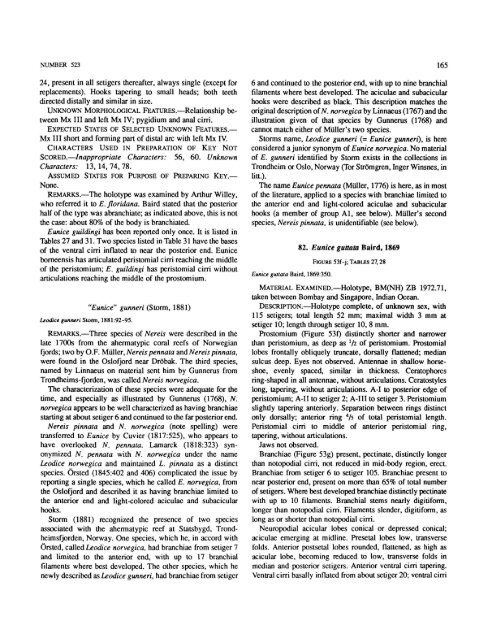A Review of the Genus Eunice - Smithsonian Institution Libraries
A Review of the Genus Eunice - Smithsonian Institution Libraries
A Review of the Genus Eunice - Smithsonian Institution Libraries
Create successful ePaper yourself
Turn your PDF publications into a flip-book with our unique Google optimized e-Paper software.
NUMBER 523 165<br />
24, present in all setigers <strong>the</strong>reafter, always single (except for<br />
replacements). Hooks tapering to small heads; both teeth<br />
directed distally and similar in size.<br />
UNKNOWN MORPHOLOGICAL FEATURES.—Relationship between<br />
Mx III and left Mx IV; pygidium and anal cirri.<br />
EXPECTED STATES OF SELECTED UNKNOWN FEATURES.—<br />
Mx III short and forming part <strong>of</strong> distal arc with left Mx IV.<br />
CHARACTERS USED IN PREPARATION OF KEY NOT<br />
SCORED.—Inappropriate Characters: 56, 60. Unknown<br />
Characters: 13,14,74,78.<br />
ASSUMED STATES FOR PURPOSE OF PREPARING KEY.—<br />
None.<br />
REMARKS.—The holotype was examined by Arthur Willey,<br />
who referred it to E. floridana. Baird stated that <strong>the</strong> posterior<br />
half <strong>of</strong> <strong>the</strong> type was abranchiate; as indicated above, this is not<br />
<strong>the</strong> case: about 80% <strong>of</strong> <strong>the</strong> body is branchiated.<br />
<strong>Eunice</strong> guildingi has been reported only once. It is listed in<br />
Tables 27 and 31. Two species listed in Table 31 have <strong>the</strong> bases<br />
<strong>of</strong> <strong>the</strong> ventral cirri inflated to near <strong>the</strong> posterior end. <strong>Eunice</strong><br />
bornecnsis has articulated peristomial cirri reaching <strong>the</strong> middle<br />
<strong>of</strong> <strong>the</strong> peristomium; E. guildingi has peristomial cirri without<br />
articulations reaching <strong>the</strong> middle <strong>of</strong> <strong>the</strong> prostomium.<br />
Leodice gunnertStorm. 1881:92-95.<br />
"<strong>Eunice</strong>" gunneri (Storm, 1881)<br />
REMARKS.—Three species <strong>of</strong> Nereis were described in <strong>the</strong><br />
late 1700s from <strong>the</strong> ahermatypic coral reefs <strong>of</strong> Norwegian<br />
fjords; two by O.F. Miiller, Nereis pennata and Nereis pinnata,<br />
were found in <strong>the</strong> Osl<strong>of</strong>jord near DrCbak. The third species,<br />
named by Linnaeus on material sent him by Gunnerus from<br />
Trondheims-fjorden, was called Nereis norvegica.<br />
The characterization <strong>of</strong> <strong>the</strong>se species were adequate for <strong>the</strong><br />
time, and especially as illustrated by Gunnerus (1768), N.<br />
norvegica appears to be well characterized as having branchiae<br />
starting at about setiger 6 and continued to <strong>the</strong> far posterior end.<br />
Nereis pinnata and N. norwegica (note spelling) were<br />
transferred to <strong>Eunice</strong> by Cuvier (1817:525), who appears to<br />
have overlooked N. pennata. Lamarck (1818:323) synonymized<br />
N. pennata with N. norwegica under <strong>the</strong> name<br />
Leodice norwegica and maintained L. pinnata as a distinct<br />
species. Orsted (1845:402 and 406) complicated <strong>the</strong> issue by<br />
reporting a single species, which he called E. norvegica, from<br />
<strong>the</strong> Osl<strong>of</strong>jord and described it as having branchiae limited to<br />
<strong>the</strong> anterior end and light-colored aciculae and subacicular<br />
hooks.<br />
Storm (1881) recognized <strong>the</strong> presence <strong>of</strong> two species<br />
associated with <strong>the</strong> ahermatypic reef at Statsbygd, Trondheimsfjorden,<br />
Norway. One species, which he, in accord with<br />
Orsted, called Leodice norvegica, had branchiae from setiger 7<br />
and limited to <strong>the</strong> anterior end, with up to 17 branchial<br />
filaments where best developed. The o<strong>the</strong>r species, which he<br />
newly described as Leodice gunneri, had branchiae from setiger<br />
6 and continued to <strong>the</strong> posterior end, with up to nine branchial<br />
filaments where best developed. The aciculae and subacicular<br />
hooks were described as black. This description matches <strong>the</strong><br />
original description <strong>of</strong> N. norvegica by Linnaeus (1767) and <strong>the</strong><br />
illustration given <strong>of</strong> that species by Gunnerus (1768) and<br />
cannot match ei<strong>the</strong>r <strong>of</strong> Muller's two species.<br />
Storms name, Leodice gunneri (= <strong>Eunice</strong> gunneri), is here<br />
considered a junior synonym <strong>of</strong> <strong>Eunice</strong> norvegica. No material<br />
<strong>of</strong> E. gunneri identified by Storm exists in <strong>the</strong> collections in<br />
Trondheim or Oslo, Norway (Tor StrOmgren, Inger Winsnes, in<br />
litt.).<br />
The name <strong>Eunice</strong> pennata (Miiller, 1776) is here, as in most<br />
<strong>of</strong> <strong>the</strong> literature, applied to a species with branchiae limited to<br />
<strong>the</strong> anterior end and light-colored aciculae and subacicular<br />
hooks (a member <strong>of</strong> group Al, see below). Muller's second<br />
species, Nereis pinnata, is unidentifiable (see below).<br />
<strong>Eunice</strong> guttata Baird, 1869:350.<br />
82. <strong>Eunice</strong> guttata Baird, 1869<br />
FIGURE 53f-j; TABLES 27,28<br />
MATERIAL EXAMINED.—Holotype, BM(NH) ZB 1972.71,<br />
taken between Bombay and Singapore, Indian Ocean.<br />
DESCRIPTION.—Holotype complete, <strong>of</strong> unknown sex, with<br />
115 setigers; total length 52 mm; maximal width 3 mm at<br />
setiger 10; length through setiger 10, 8 mm.<br />
Prostomium (Figure 530 distinctly shorter and narrower<br />
than peristomium, as deep as l /2 <strong>of</strong> peristomium. Prostomial<br />
lobes frontally obliquely truncate, dorsally flattened; median<br />
sulcus deep. Eyes not observed. Antennae in shallow horseshoe,<br />
evenly spaced, similar in thickness. Ceratophores<br />
ring-shaped in all antennae, without articulations. Ceratostyles<br />
long, tapering, without articulations. A-I to posterior edge <strong>of</strong><br />
peristomium; A-II to setiger 2; A-III to setiger 3. Peristomium<br />
slightly tapering anteriorly. Separation between rings distinct<br />
only dorsally; anterior ring 4 /s <strong>of</strong> total peristomial length.<br />
Peristomial cirri to middle <strong>of</strong> anterior peristomial ring,<br />
tapering, without articulations.<br />
Jaws not observed.<br />
Branchiae (Figure 53g) present, pectinate, distinctly longer<br />
than notopodial cirri, not reduced in mid-body region, erect.<br />
Branchiae from setiger 6 to setiger 105. Branchiae present to<br />
near posterior end, present on more than 65% <strong>of</strong> total number<br />
<strong>of</strong> setigers. Where best developed branchiae distinctly pectinate<br />
with up to 10 filaments. Branchial stems nearly digitiform,<br />
longer than notopodial cirri. Filaments slender, digitiform, as<br />
long as or shorter than notopodial cirri.<br />
Neuropodial acicular lobes conical or depressed conical;<br />
aciculae emerging at midline. Presetal lobes low, transverse<br />
folds. Anterior postsetal lobes rounded, flattened, as high as<br />
acicular lobe, becoming reduced to low, transverse folds in<br />
median and posterior setigers. Anterior ventral cirri tapering.<br />
Ventral cirri basally inflated from about setiger 20; ventral cirri
















